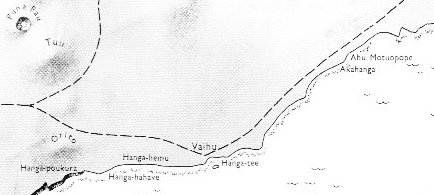8. Another important task for the kuhane was to search for a proper place for the residence of the king who would come later. The dream soul climbed up and reached the rim of the crater. As soon as the dream soul looked into the crater, she felt a gentle breeze coming toward her. She named the place 'Poko Uri A Hau Maka O Hiva'. The dream soul continued her search for a residence for King Matua. The dream soul of Hau Maka reached (the smaller crater) Manavai and named the place 'Te Manavai A Hau Maka O Hiva'. The dream soul went on and reached Te Kiore Uri. She named the place 'Te Kiore Uri A Hau Maka O Hiva'. The dream soul went on and came to Te Piringa Aniva. She named the place 'Te Piringa Aniva A Hau Maka O Hiva'. Again the dream soul went on her way and reached Te Pei. She named the place 'Te Pei A Hau Maka O Hiva'. The dream soul went on and came to Te Pou. She named the place 'Te Pou A Hau Maka O Hiva'. The dream soul went on and came to Hua Reva. She named the place 'Hua Reva A Hau Maka O Hiva'. The dream soul went on and came to Akahanga. She named the place 'Akahanga A Hau Maka O Hiva'.
The last of the mentioned places, Akahanga, is halfway from Rano Kau to Rano Raraku, and it can be seen at right in the map above. The other places named are not equally important if we should judge purely from the geography of the island. But they are primarily located in time and not in space, which means their importance cannot be judged from a normal kind of map. However, Barthel has painstakingly tried to locate them on a normal map. Even if they are located in time they are, so to say, reflected on the ground, and when the creators of Manuscript E (or their predecessors) thought about names they would have chosen places on the ground which alluded to the places in time. The king to come is said to be Matua, a name which we can translate as 'father':
Though I think 'the part of a net from which the weaving started' could be more expressive of his true nature: ... Five days of illumination, called the 'Lighting of the Flame' (which in the earlier reading of this miracle play would have followed the quenching of the fires on the dark night of the moon when the king was ritually slain), preceded the five days of the festival itself; and then the solemn occasion (ad majorem dei gloriam) commenced. The opening rites were under the patronage of Hathor. The king, wearing the belt with her four faces and the tail of her mighty bull, moved in numerious processions, preceded by his four standards, from one temple to the next, presenting favors (not offerings) to the gods. Whereafter the priesthoods arrived in homage before his throne, bearing the symbols of their gods. More processions followed, during which, the king moved about - as Professor Frankfort states in his account - 'like the shuttle in a great loom' to re-create the fabric of his domain, into which the cosmic powers represented by the gods, no less than the people of the land, were to be woven ... The king (or pharaoh) moves 'like the shuttle in a great loom', traversing it all the way to its 4 corners. In his dream Hau Maka moves in a similar way. At any rate I guess Matua is meant to be a Sun King, endowed by myth with such traits as a Sun King should have. Possibly he once was real king who went to Easter Island, but the important thing is that he had become a mythical Sun King at the time of the creators of Manuscript E. Keeping this in mind is necessary if we wish to truly understand the contents of the manuscript. |
